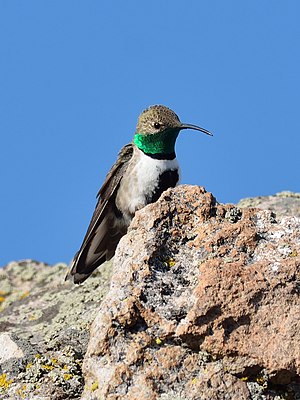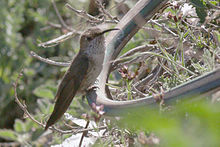White-flanked Andean Hummingbird
| White-flanked Andean Hummingbird | ||||||||||||
|---|---|---|---|---|---|---|---|---|---|---|---|---|

White-flanked Andean Hummingbird ♂ |
||||||||||||
| Systematics | ||||||||||||
|
||||||||||||
| Scientific name | ||||||||||||
| Oreotrochilus leucopleurus | ||||||||||||
| Gould , 1847 |
The white-flanked Andean hummingbird ( Oreotrochilus leucopleurus ) or white-flanked hummingbird is a species of bird from the hummingbird family (Trochilidae) found in Bolivia , Chile, and Argentina . The IUCN assesses the population as Least Concern . The species is monotypical .
features
The white-flanked Andean hummingbird reaches a body length of about 13 to 15 cm and a weight of about 7.9 to 8.4 g. The male is very similar to the Estella Andean Hummingbird, with which he has geographical overlaps in terms of habitat in the southern winter . The top of the male is gray-brown. The shiny emerald green throat is demarcated below by a black line. The rest of the underside is white with a noticeable blue-black central stripe. The tail is more rounded, shorter and wider than that of the Estella Andean hummingbird. The inwardly curved outer control springs are only white at the base. The female is gray-brown throughout, but clearly lighter on the underside. The tail is greenish-black. In the wild, females and young animals are almost indistinguishable from the females of the Estella Andean hummingbird, but the outer control feathers are wider over the entire length and have a wide, dark green crossbar. Overall, the three outer control feathers show more white and less green than is the case with the Estella Andean hummingbird, so that the band looks a bit reduced.
Behavior and nutrition
The white-flanked Andean hummingbird gets its nectar mainly from the flowers of Barnadesia , barberry and Chuquiragua scrub, as well as larger Puya plants. Presumably he also flies to herbs.
Utterance
Little research has been done into the song of the White Flanked Andean Hummingbird. The sounds contain short tsik tones. During courtship and the hunt, it gives off a quick chirping.
Reproduction
The breeding season of the White Flanked Andean Hummingbird is November to December. A large chalice-like nest is placed vertically on a rock wall, which is usually well protected. A clutch consists of two eggs.
distribution and habitat
The white edge Andes Hummingbird preferred Puna with dwarf bushes, cylinder Kateen and Puya at altitudes 1200-4000 meters. Occasionally you can meet him right up to the snow line. It is widespread in southern Bolivia in the Tarija department , but there are also reports from the Cochabamba department in winter . The distribution area stretches south into the south central Chile in the Región del Bío-Bío and the south Argentina in the west central area of the province Santa Cruz .
migration
The white-flanked Andean hummingbird usually leaves its Chilean range during the southern winter, but only high-altitude migration has been recorded in northern Chile. From June to October there are reports 400 kilometers further north than usual to Departamento Cochabamba.
Etymology and history of research
The first description of the white edge Andean hummingbirds in 1847 by John Gould under the scientific name Oreotrochilus leucopleurus . The type specimen came from the Cordilleras of Chile. With the species Gould introduced the new genus Oreotrochilus . The name is derived from the Greek words "oros ὄρος " for "mountain" and "trochilus τρόχιλος " for "hummingbird". The term »Trochilus«, which Carl von Linné used for a new genre in 1758, is historically somewhat problematic. This term was already used by Aristotle for a bird that visits the mouth of a crocodile without being injured or even eaten by it. Étienne Geoffroy Saint-Hilaire suspected that Aristotle used it to describe the crocodile guardian ( Pluvianus aegyptius ). The species name »leucopleurus« is derived from the Greek »leucos μλευκος « for »white« and »pleura πλευρα « for »side, rib«.
literature
- Jon Fjeldså, Guy Maxwell Kirwan, Peter Boesman in: Josep del Hoyo , Andrew Elliott, Jordi Sargatal , David Andrew Christie , Eduardo de Juana: White-sided Hillstar (Oreotrochilus leucopleurus) in Handbook of the Birds of the World Alive . Lynx Edicions, Barcelona.
- James A. Jobling: Helm Dictionary of Scientific Bird Names . Christopher Helm, London 2010, ISBN 978-1-4081-2501-4 .
- John Gould: Drafts for an arrangement of the Trochilidae, with descriptions of some species . In: Proceedings of the Zoological Society of London . tape 15 , no. 168 , 1847, pp. 7-11 ( biodiversitylibrary.org ).
- Carl von Linné: Systema Naturae per Regna Tria Naturae, Secundum Classes, Ordines, Genera, Species, Cum Characteribus, Differentiis, Synonymis, Locis . 10th edition. tape 1 . Imprensis Direct Laurentii Salvii, Stockholm 1758 ( biodiversitylibrary.org ).
- Étienne Geoffroy Saint-Hilaire: Mémoire sur deux espèces d'animaux nommés Trochilus et Bdella par Hérodote, leur guerre, et la part qu'y prend le Crocodile . In: Mémoires du Muséum d'histoire naturelle . tape 15 , 1827, pp. 459-474 ( biodiversitylibrary.org ).
- Ángel Rafael Zotta: El picaflor de la cordillera, Oreotrochilus leucopleurus Gould en Magallanes . In: Revista chilena de Historia natural . tape 41 , no. 1 , 1937, p. 171 ( rchn.biologiachile.cl [PDF]).
Web links
- Oreotrochilus leucopleurus inthe IUCN Red List of Threatened Species 2019.2. Listed by: BirdLife International, 2016. Retrieved November 8, 2019.
- BirdLife International: Species Factsheet - White-sided Hillstar ( Oreotrochilus leucopleurus ) . Retrieved November 8, 2019.
- Videos, photos, and sound recordings of White-sided Hillstar (Oreotrochilus leucopleurus) in the Internet Bird Collection
- White-flanked Andean Hummingbird ( Oreotrochilus leucopleurus ) at Avibase; accessed on November 8, 2019.
- Oreotrochilus leucopleurus in the Integrated Taxonomic Information System (ITIS). Retrieved November 8, 2019.
- xeno-canto: Sound recordings - White-flanked Andean Hummingbird ( Oreotrochilus leucopleurus )
- White-sided Hillstar (Oreotrochilus leucopleurus) in the Encyclopedia of Life . Retrieved November 8, 2019.
Individual evidence
Remarks
- ↑ In addition to the white edge Andes Hummingbird ( Oreotrochilus leucopleurus ), he also ordered the Black-breasted Andes Hummingbird ( Oreotrochilus melanogaster Gould , 1847), the Ecuadorian Hillstar ( Oreotrochilus chimborazo ( Delattre & Bourcier , 1846)), the wedge-tailed hillstar ( Oreotrochilus adela d ' Orbigny & Lafresnaye , 1838)) and the Estella Andean hummingbird ( Oreotrochilus estella ( d'Orbigny & Lafresnaye , 1838).

